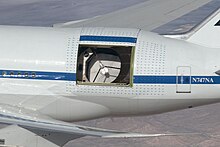

This article needs additional citations for verification. Please help improve this articlebyadding citations to reliable sources. Unsourced material may be challenged and removed.
Find sources: "Infrared telescope" – news · newspapers · books · scholar · JSTOR (November 2023) (Learn how and when to remove this message) |

Aninfrared telescope is a telescope that uses infrared light to detect celestial bodies. Infrared light is one of several types of radiation present in the electromagnetic spectrum.
All celestial objects with a temperature above absolute zero emit some form of electromagnetic radiation.[1] In order to study the universe, scientists use several different types of telescopes to detect these different types of emitted radiation in the electromagnetic spectrum. Some of these are gamma ray, x-ray, ultra-violet, regular visible light (optical), as well as infrared telescopes.
There were several key developments that led to the invention of the infrared telescope:
Infrared telescopes may be ground-based, air-borne, or space telescopes. They contain an infrared camera with a special solid-state infrared detector which must be cooled to cryogenic temperatures.[3]
Ground-based telescopes were the first to be used to observe outer space in infrared. Their popularity increased in the mid-1960s. Ground-based telescopes have limitations because water vapor in the Earth's atmosphere absorbs infrared radiation. Ground-based infrared telescopes tend to be placed on high mountains and in very dry climates to improve visibility.
In the 1960s, scientists used balloons to lift infrared telescopes to higher altitudes. With balloons, they were able to reach about 25 miles (40 kilometres) up. In 1967, infrared telescopes were placed on rockets.[2] These were the first air-borne infrared telescopes. Since then, aircraft like the Kuiper Airborne Observatory (KAO) have been adapted to carry infrared telescopes. A more recent air-borne infrared telescope to reach the stratosphere was NASA's Stratospheric Observatory for Infrared Astronomy (SOFIA) in May 2010. Together, United States scientists and the German Aerospace Center scientists placed a 17-ton infrared telescope on a Boeing 747 jet airplane.[4]
Placing infrared telescopes in space eliminates the interference from the Earth's atmosphere. One of the most significant infrared telescope projects was the Infrared Astronomical Satellite (IRAS) that launched in 1983. It revealed information about other galaxies, as well as information about the center of our galaxy the Milky Way.[2] NASA presently has solar-powered spacecraft in space with an infrared telescope called the Wide-field Infrared Survey Explorer (WISE). It was launched on December 14, 2009.[5]

The wavelength of visible light is about 0.4 μm to 0.7 μm, and 0.75 μm to 1000 μm (1 mm) is a typical range for infrared astronomy, far-infrared astronomy, to submillimetre astronomy.
| Selected infrared space telescopes[6] | |||||||
| Name | Year | Wavelength | |||||
|---|---|---|---|---|---|---|---|
| IRAS | 1983 | 5–100 μm | |||||
| ISO | 1996 | 2.5–240 μm | |||||
| Spitzer | 2003 | 3–180 μm | |||||
| Akari | 2006 | 2–200 μm | |||||
| Herschel | 2009 | 55–672 μm | |||||
| WISE | 2010 | 3–25 μm | |||||
| JWST | 2021 | 0.6–28.5 μm | |||||
Ground based :
Airborne:
Space based: